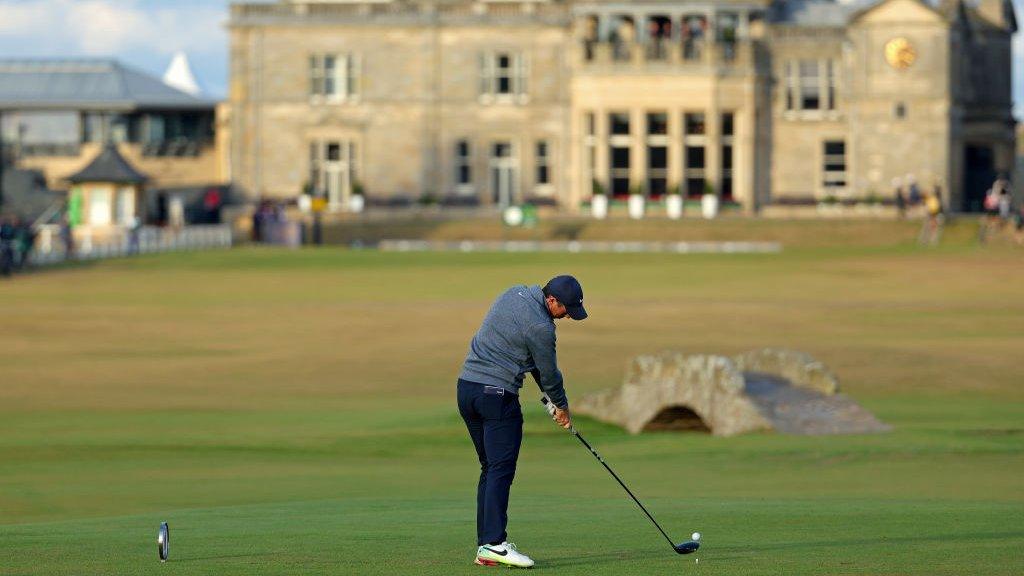R&A proposes rule change to reduce ball distance by 2026 Open Championship
- Published

The 18th at the Old Course in St Andrews is one of the par-four holes that are driveable for the professionals
Players at future Open Championships are likely to be forced to use specially adapted golf balls that will not fly as far as ones in use today, under new rules proposed by the R&A.
It is hoped the plans, which focus on ball specifications and do not affect large-headed drivers, will be adopted across elite golf in 2026.
The move will reduce the length of tee shots by about 15 yards.
At last week's Players Championship, Rory McIlroy hit a tee shot 362 yards.
Top players have been propelling drives further than ever with distances increasing year on year. This has prompted widespread concern that golf courses are becoming too short to test the best players in the world.
For next month's Masters, Augusta National's iconic par-five 13th hole has been extended 35 yards to 545 yards because it was judged too easy for the top professionals in recent tournaments.
There were fears that the Old Course at St Andrews would prove too short for last year's 150th Open and several of the par-four holes proved drivable for the world's best players.
The golf industry is also feeling the impact of sustainability requirements and an extra need for water to maintain extended courses.
This planned rule change would not affect amateur recreational players.
"We strongly feel we have crossed the rubicon on distance and that we had to do something," R&A chief executive Martin Slumbers told BBC Sport. "Doing nothing is not an option and would be completely irresponsible of us."
The R&A and fellow rule-makers, the United States Golf Association, have been examining distance issues for the past six years. Debate on the topic has raged for decades while golf courses have grown longer and longer.
These proposals follow feedback after publication in 2020 of the joint R&A and USGA Distance Insights project. Initial plans included modifying specifications to drivers used by top players.
But they have been scrapped. Instead, they are proposing a Model Local Rule (MLR) that would allow organisers of elite events to insist on the use of a distance-reducing tournament ball.
"We had three very large pieces of feedback," Slumbers said. "One was, please do not affect the recreational game. It is in a good place at the moment."
The others highlighted a difficulty of legislating on club specifications - three-wood shots might travel further than amended drivers - and concerns over the complexity and expense of the initial recommendations.
"The best solution is a Model Local Rule around the golf ball," Slumbers said. "And that would be structured in a way that would be for elite golf, which is far more than just professional golf."
Under the proposals, a ball struck at a laboratory-controlled swing speed of 127mph must not travel more than 320 yards. Data provided for last year's Annual Driving Distance Report showed an average clubhead speed of 114.6mph on the PGA Tour.
"The net effect of that on an average tour player is [a reduction of] about 14 to 15 yards," Slumbers explained.
The PGA and DP World Tours have been opposed to limiting the driving power of their players, and manufacturers are thought to be against reducing the potency of their products.
"It would be optional and there are a lot of conversations that need to be had over the next couple of years," Slumbers said. The golf industry has six months to provide further feedback.
"If this is where we do end up you'd certainly expect it to be used in The Open and our Amateur Championship," the R&A boss added.
Slumbers says it has been a painstaking and collaborative process to arrive at a point where firm recommendations have now been made. He also insists this will not discriminate against golf's biggest hitters.
"The best drivers of the golf ball will always be the best drivers of the golf ball," he said. "Everything is relative. But I believe the game is not just about driving but the whole balance of clubs right through the bag."
He says the rules makers are now moving into "the endgame". Slumbers added: "We have been hugely collaborative with manufacturers, players, tours, all sorts of people right across the industry.
"There is a real mixture of issues that need to be reconciled as we move forward.
"But the R&A does have this custodial responsibility for protecting the integrity of the game. This is what we believe is the right way for the sport to go."

Release or detain? A raw documentary goes inside the high-stakes world of parole hearings
What's life like with an electronic tag? Follow four youngsters whose every move is monitored

